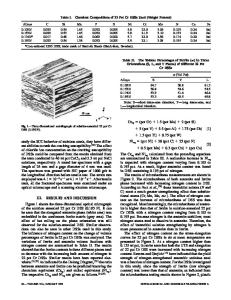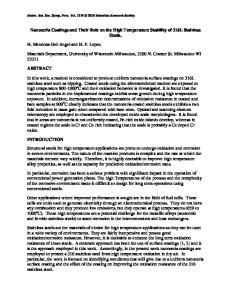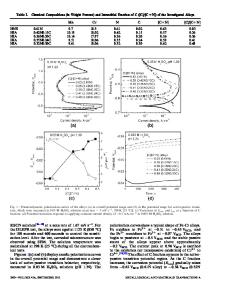Thermodynamic Calculation Study on Effect of Manganese on Stability of Austenite in High Nitrogen Stainless Steels
- PDF / 975,337 Bytes
- 5 Pages / 593.972 x 792 pts Page_size
- 67 Downloads / 385 Views
excellent combination of properties, high nitrogen stainless steels (HNS), especially the austenitic HNS, have attracted significant attention from researchers.[1,2] As a result of the benefits of nitrogen alloying, HNS acquire an excellent combination of high strength and good ductility.[3] Furthermore, the addition of nitrogen, especially together with molybdenum, significantly improves the localized corrosion resistance of HNS. Generally, HNS contain high-manganese content to increase the solubility of nitrogen.[1] However, the effect of manganese on the stability of austenite is very confusing. Although many investigations have been performed on the role of manganese in stainless steels, this fundamental problem is still unclear. In the past decades, many constituent diagrams have been proposed and widely used to illustrate the relationship between composition and microstructure in stainless steels. The nickel (or nitrogen) equivalent and
QINGCHUAN WANG, Ph.D. Student, and BINGCHUN ZHANG and KE YANG, Professors, are with the Institute of Metal Research, Chinese Academy of Sciences, Shenyang 110016, China. Contact e-mail: [email protected] Manuscript submitted December 2, 2015. Article published online May 3, 2016 3284—VOLUME 47A, JULY 2016
chromium equivalent in diagrams are applied to express the austenite and ferrite stabilizing ability of alloying elements. As shown in Table I, the values of nickel equivalents of manganese are very different in diagrams. Manganese behaves as a strong austenite stabilizer in Schaeffler[4] and Delong[5] diagrams. However, in the other diagrams,[6–8] the austenite stabilizing ability of manganese is weak, and it could become a ferrite stabilizer at high manganese content. In fact, until now, the role of manganese is still debatable. Meanwhile, the behaviors of other alloying elements in diagrams such as molybdenum are different as well. Nevertheless, no attempt has been made to account for the difference among diagrams, and the applicable scopes of these diagrams are still unknown. According to the previous studies, Schaeffler and Delong proposed their diagrams by study of low-manganese stainless steels, which have been found unsuitable for the high-manganese (above 4 wt pct) steels since World War II.[9] Then, Hull and Speidel diagrams took both low-manganese and high-manganese steels into consideration, but they are found still inaccurate for high-manganese stainless steels.[10–12] For high-manganese HNS, a new diagram with a different equivalent formula was proposed in our previous study. It is obvious that manganese plays an important role in the development of diagrams for stainless steels. Furthermore, few previous works have suggested the role of manganese varied with the chromium content in Fe-Cr-Mn-C and Fe-Cr-Mn-Ni steels.[13–15] However, none of the aforementioned diagrams considered the interaction among the alloying elements. According to the research above, the behavior of alloying elements in different type of stainless steels is very similar to each other. Therefore, the effe
Data Loading...











